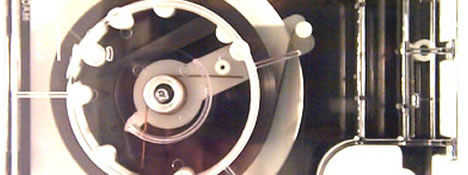A digital decree.
Should scratches on the surface show,
Be gentle with CD.
I’m very glad to have missed the digital revolution at the undergraduate station. By the time I showed up as a freshman the control room had a lop-sided majority of compact discs over long-playing records; probably 20:1 if not higher. Judging on the deterioration of the rock records that were still in rotation, it would been interesting to see how the station coped with its main source of music in ruins: records scratched or broken, sleeves ripped and torn, and playback equipment not kept up to...well, speed.
Enter the compact disc: 74 minutes of digital audio that didn’t suffer from generation loss and was easier to manage and store. Just the thought of long-playing suites spread out over multiple records makes me cringe when I think of the station’s classical library on any non-digital medium. Honestly though, I never knew if the station was ever in that predicament. I never saw classical record holdovers, it was always rock, R&B, or jazz. If that’s the case then our classical collection was relatively new – all 700+ discs of it.
We talked about compact discs in Dr. Propel’s introduction class – and gave them a spin in our lab sessions – but I don’t recall anything that stands out. That probably goes hand-in-hand with those 700 classical CDs: the format had inundated all facets of the broadcasting industry to the point the discs were commonplace and not conversation pieces. Whatever novelty factor they had was long gone. Granted even at college you did run into a few audiophiles who belittled the re-mastered discs and said Zeppelin sounded more pristine and “true” when heard on an old turntable. I always found these rants funny coming from someone my age, someone who was born in the midst of Led Zeppelin’s heyday. You know, someone twentieth-century minded.
Led Zeppelin brings to mind the “classic rock” format, which would have been a good way to use the station’s scattered record collection had it survived. When it was decided about my sophomore/junior year to add a weekend classic rock show we had to go out and purchase copies of all the old standbys: Boston, Fleetwood Mac, the Doobie Brothers, and so on. If only we had kept our collection in better shape! What was purchased at the time as “modern” music would have aged perfectly into “classic” rock in a mere 20 years. Makes you wonder how some of the songs mentioned on Backsells will sound in 2010.

Joey ended up with one of the classic rock shifts one semester and this drove some of us nuts. It wasn’t so much his presentation on air – he was nothing like the Young Dude I would meet a year or so later – but his mannerisms and methods behind the scenes. Student management had made Joey a format coordinator – a position that helped the Music Director – and in this position Joey kept stock of the classic rock library. The main duty in this role was printing playlists for the coming week. Joey “helped” us out by adding tracks to the playlist programming software and added occasional bits of trivia for various songs. The catch was that on tracks he couldn’t find anything to add he simply noted, “Be Gentle with CD.”
In Joey’s defense he didn’t add this note to every song right off the bat. But if “Main Street” on the Bob Seger album didn’t skip on his shift last week and it was today, you knew during the next week that the CD would be cleaned and polished with his personal cleaning kit and a note would be added to the playlist for the following Saturday.
Be gentle with CD.
And yes, the phrase got to be a bit of a joke after a while. Especially when it started surfacing elsewhere: taped to CD cases or written across the top of your playlist or even brought up in management meetings as something funny you heard from the previous week.
Ooops. Sorry, Joey.
Stay gentle.
- - - - - - - - - - - -
21st Century (Digital Boy)
(Brett Gurewitz/Mr. Brett)
Bad Religion
From the album Against the Grain
1990
I cant believe it, the way you look sometimes,
Like a trampled flag on a city street, oh yeah,
And I dont want it, the things youre offering me,
Symbolized bar code, quick id, oh yeah,
cause Im a 21st century digital boy,
I dont know how to live but Ive got a lot of toys,
My daddys a lazy middle class intellectual,
My mommys on valium, so ineffectual,
Aint life a mystery?
I cant explain it, the things theyre saying to me,
Its going yayayayayayaya, oh yeah,
cause Im a 21st century digital boy,
I dont know how to read but Ive got a lot of toys,
My daddys a lazy middle class intellectual,
My mommys on valium, so ineffectual,
Aint life a mystery?
I tried tell you about no control,
But now I really dont know,
And then you told me how bad you had to suffer,
Is that really all you have to offer?
See Im a 21st century digital boy,
I dont know how to read but Ive got a lot of toys,
My daddys a lazy middle class intellectual,
My mommys on valium, so ineffectual,
Thats what I yearn for (21st century digital boy),
Neurosurgeons scream for more (21st century digital boy),
Innocence raped with napalm fire (21st century digital boy),
Anything I want I really need (21st century digital boy),
21st century schitzoid boy (21st century digital boy),
21st century video boy (21st century digital boy),
21st century digital boy (21st century digital boy),
21st century sofa boy (21st century digital boy)...



